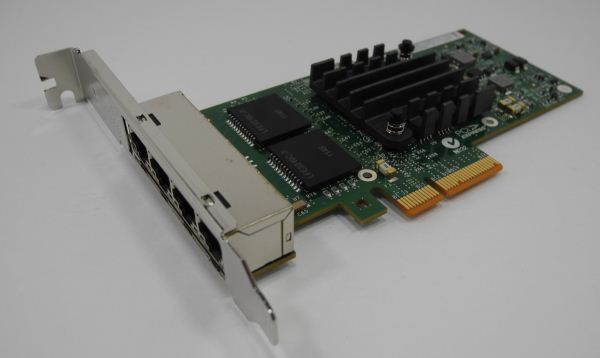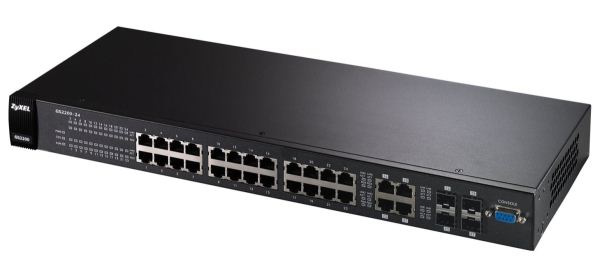Building the 2012 AnandTech SMB / SOHO NAS Testbed
by Ganesh T S on September 5, 2012 6:00 PM EST- Posted in
- IT Computing
- Storage
- NAS
The Asus Z9PE-D8 WS has 2 GbE ports. However, we have several VMs trying to stress the NAS under test. Sharing two GbE links across 12 VMs was never going to be a suitable solution. The testbed used in earlier reviews had an Intel ESA-I340 quad-port GbE network adapter. Based on the Gigabit 82580, it has a PCIe 2.0 x4 connection enabling it to provide maximum bidirectional throughput for all the four GbE ports.
The Z9PE-D8 WS has 7 PCIe slots, and we decided to fill up three of them with the Intel ESA-I340 cards. They provided a total of twelve physical GbE ports, one for each VM. The ESA I-340 has a full height form factor, but also comes with a low profile bracket. One of the interesting aspects of the I340 server adapter is the VMDq (Virtual Machine Device Queue). It reduces I/O overhead in the hypervisor (and lowers CPU usage) by maintaining hardware queues for data packets sorted by their destination and sending them later to the hypervisor for forwarding to the appropriate VM. Even though we had the VMDq feature enabled in the settings for all the adapters, it probably had negligible effect on the CPU usage in our workloads because we had each VM reserving one port exclusively for its own use. The host machine itself connected to the network through one of the native GbE ports on the motherboard.
Between the NAS testbed and the NAS under test, it is essential that we have a switch capable of standing up to the stressful network traffic. Our switch of choice was one of the 24-port managed enterprise models from ZyXel, the GS2200-24. Even though it is advertised as a 24-port model, it actually has 4 extra ports with dual personalities (i.e, both copper and optical SFP).
The switch has all the necessary features for an L2 managed model including VLANs, CoS/QoS, port trunking and bandwidth control. Port trunking / 802.3ad LACP aggregation is essential because NASes with dual GbE ports provide that as an option to increase performance. Even though a NAS might support link aggregation, it is of no use if the switch to which it is connected doesn’t aggregate the connected ports.












74 Comments
View All Comments
waldo - Wednesday, September 5, 2012 - link
Some of the biggest problems I have found in running my small business related to NAS's is file integrity under load. Is there a way to see if they have file integrity issues under load? Not just i/o or response times.Also, it would be interesting to see how their "feature set" holds up under load, as all of the NAS's purport to offer a variety of additional services other than purely file access/storage. Or is that only applicable to your lengthier reviews?
Lastly, most of these nas's don't have version tracking or something similar, so in a media setup, it would be interesting to see how they handle accessing the same file at the same time....can they serve it multiple times to multiple clients?
waldo - Wednesday, September 5, 2012 - link
One last thought...it would be interesting to see free nas or some other DIY as an alternative.Peanutsrevenge - Wednesday, September 5, 2012 - link
Top marks!Bet it was satisfying when the SSH script was comlpete, just press this button and .....
tygrus - Thursday, September 6, 2012 - link
How big a NAS can you test ? Does the server slow it down when testing 7+ virtual client load against NAS ? What is the client/host CPU usage, host system_cpu%, VM overhead ?Please test the server by running simultaneous tests to multiple NAS. Compare 6 clients alone to 1 NAS at a time with 2 sets of 6 clients to 2 NAS (or 3x4, 4x3). Is there any difference ? Is the test affected by the testbed CPU speed (try using a faster CPU eg. E5-2670) ? Can you test 16 or 24 clients (1 server) with 2 VM / SSD. Might need more RAM ? Now we are getting less SMB / SOHO and more enterprise :)
jwcalla - Thursday, September 6, 2012 - link
I got a bit of a chuckle out of G.Skill sending you non-ECC RAM.ganeshts - Thursday, September 6, 2012 - link
That is OK for our application :) We aren't running this workstation in a 'production' environment.bobbozzo - Thursday, September 6, 2012 - link
Curious, would ECC RAM use noticeably more power?extide - Thursday, September 6, 2012 - link
Why would they bother with ECC ram? Totally un-needed for this application..bsd228 - Monday, September 10, 2012 - link
ECC is absolutely needed for this application - Data integrity matters, not just data throughput.bobbozzo - Thursday, September 6, 2012 - link
Page 2, in the sentence"Out of the three processors, we decided to go ahead with the hexa-core Xeon E5-2630L"
The URL in the HREF has a space in it, and therefore doesn't work.
Thanks for the article!